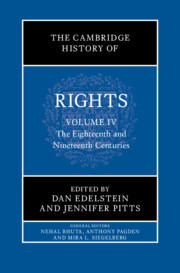Book contents
- the cambridge history of rights
- The Cambridge History of Rights
- The Cambridge History of Rights
- Copyright page
- Contents
- Figures
- Contributors to Volume IV
- General Introduction
- A Note on Translations
- Introduction to Volume IV
- Part I A Revolution in Rights?
- Part II Postrevolutionary Rights
- Part III Rights and Empires
- Index
Introduction to Volume IV
Published online by Cambridge University Press: 22 January 2025
- the cambridge history of rights
- The Cambridge History of Rights
- The Cambridge History of Rights
- Copyright page
- Contents
- Figures
- Contributors to Volume IV
- General Introduction
- A Note on Translations
- Introduction to Volume IV
- Part I A Revolution in Rights?
- Part II Postrevolutionary Rights
- Part III Rights and Empires
- Index
Summary
Writers during the age of the Enlightenment and revolutions did such a good job “declaring” rights that many historians and politicians later believed that they invented them. But as we show in this volume (the fourth in a chronological series), this assumption is flawed. What’s more, many of the earlier characteristics of rights – in particular, their connection to religion – remained present through the revolutions of the late eighteenth and early nineteenth centuries. Rights became a means of liberation for religious minorities, the economic downtrodden, women, slaves, and others. But rights also became a means of control, especially in the European colonies around the world, as well as in liberal economic regimes that protected property rights. Overall, the transformations of rights during this period were so great that it can make earlier expressions of rights seem unrelated. But, as this volume shows, the eighteenth and nineteenth centuries are better understood as a crucial time of transformation, repackaging rights for a modern world
Keywords
- Type
- Chapter
- Information
- The Cambridge History of Rights , pp. 1 - 12Publisher: Cambridge University PressPrint publication year: 2024

